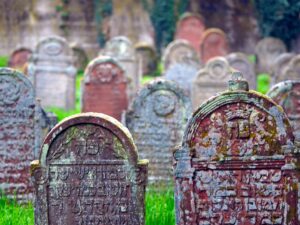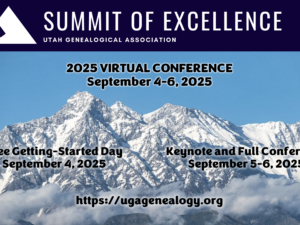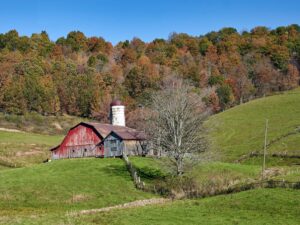Memorializing Family History - From Intimidation to Empowerment
- Description
- Curriculum
Genealogists value the power and legacy of the written word. We all love to research. Some love to write. Others, fueled by intimidation and self-doubt, guiltily procrastinate the writing, secretly hoping for a miracle. This course may just be the beginning of a miracle.
Karen Stanbary will share her passion for storytelling. Trained as a clinician, she will blast away your writing obstacles and empower you to finally memorialize the stories that deserve to be preserved.
This all-new course adapts the successful structure widely applauded in national writing workshops, making it a bit gentler.
Students select from the following topics:
- Document one event in the life of a recently deceased ancestor such as a beloved parent or grandparent. Employing a deep dive into documentary sources, the writing will pinpoint the event within a historical context.
- Document the oral history about a treasured family heirloom. The writing will tell the story while stressing the meaning of the piece to the family. Documentary sources will add texture to the tale.
- Document your ancestor’s participation in a specific military engagement, incorporating images as possible.
- Document the historical context and the story hidden within a family photograph.
Between classes, students will be required to engage in anonymous peer review and will edit their work with a focus on creative, but tight writing. The final piece is intended to preserve the stories down through generations.
September 9, 2025 MDT
Week 1: Blast the block. Creative Sparks. Show and Tell
9:00–9:30 Course Overview
9:30–10:00 Blast the block: From Intimidation to Empowerment
An experiential exercise designed to cognitively reframe obstacles to opportunities.
10:00–10:15 Break
10:15–11:45 The Rough Draft: Faculty Show and Tell
Faculty each walk students through the beginning phases of their selected projects. The project typically begins with family lore or provenance details of a treasured heirloom.
11:45–12:45 Lunch
Students select a topic by the conclusion of lunch.
12:45–2:15 The Rough Draft: Faculty Show and Tell, continued
2:15–2:30 Break
2:30–3:45 Emotional Impact: Student Show and Tell
Students break into small groups of five to “show and tell” the chosen topic. Peers provide feedback.
3:45–4:00 The Pledge
Students make a solemn promise to find joy in the process and to bat away the harsh inner critic. Students remind themselves that their ancestors want their stories to be told and will be there, accompanying them on the journey. Students promise to view the next weeks as an opportunity to point out the resiliency in their family narrative.
HOMEWORK: The student commits the story to the written word in a rough draft. The first draft may not exceed 2000 words. No source citations nor research allowed (this week).
September 16, 2025
Week 2: Decisions, Decisions, Decisions: Documentation and Historical Context
8:30–9:00 Coffee with Karen and Angela
Explore surprises. Defeat obstacles. Harness resistance. Fuel the passion. Share excitement. Listen to Angela and Karen discuss their experiences about the writing and editing process.
9:00–9:30 The Role of Documentation & Historical Context (Stanbary)
Karen will provide strategies to select the best sources to document the events in the story. Historical context choices should add texture but not distract from the story.
9:30–9:45 Break
9:45–11:30 The Polished Product: Documentation and Historical Context
Faculty share each of their final pieces that include documentation and historical context. They will emphasize the decisions, reasoning and strategies that fuel the writing choices.
11:30–12:30 Lunch
12:30–2:15 The Polished Product: Documentation and Historical Context, continued
2:15–2:30 Break
2:30–3:00 Positive and Constructive Peer Review
Angela will provide tips for positive and constructive peer review.
3:00–4:00 Think Tank
Students volunteer topics for the class and faculty to brainstorm sources for documentation and historical context.
HOMEWORK: Two weeks to complete the assignments.
- Revise the first draft.
- Add documentation.
- Add historical context.
- NO MORE THAN 3,000 words (not including footnotes/endnotes)
- Email the piece anonymously by midnight, September 22.
- Read the anonymous works assigned to you and prepare a one-page critique (the first gift) for each writer. Include suggestions for spelling, grammar, and word choice. Suggest sources. Highlight interesting passages. Suggest omission of unnecessary passages. Identify confusing passages. Propose a different structure. Email the anonymous gifts by midnight, September 26. Only the SLIG Director and Karen will know who is writing what.
- Edit your piece considering peer feedback prior to September 30
September 30, 2025
Week 3: Goosebumps & Tears: Creating Emotional Impact
8:30–9:00 Coffee with Karen
Karen will lead a discussion about presentism.
9:00–10:15 Hands On: Word Choice
The class will complete and discuss an exercise designed to stimulate ideas about emotionally impactful word choices.
10:15–10:30 Break
10:30–11:45 Hands On: Creative Structure and Unconventional Viewpoints
In small groups, the class will re-structure a work sample to make the piece more engaging. They will create the opening paragraph and topic sentences.
11:45–12:45 Lunch
12:45–4:00 The Workshop
Volunteers (selected by lottery as time permits) seek class feedback. The student may read his or her piece to the class or select a friend to read it on his or her behalf. The class will offer a broad reaction to the peer’s written piece emphasizing the strengths and emotional impact. The class discusses the piece while the writer listens and takes notes. The writer may ask questions of the readers at the conclusion of the discussion. The class will assist the writer to restructure the piece and tighten the writing.
HOMEWORK: Based on privately shared feedback and in-class comments, restructure and edit the piece.
October 14, 2024
Week 4: Visual Details Add Texture
8:30–9:00 Coffee with Karen
Karen will provide examples of writing that invites the reader to experience the story using four senses.
9:00–10:15 Sources for Visual Enhancements
We will discuss sources and strategies to enrich the story with digital images, maps, illustrations, and other visually interesting details.
10:15–10:30 Break
10:30–11:45 Brainstorming
Students break into small groups and brainstorm ideas to add visual interest to each specific story.
11:45–12:45 Lunch
12:45–4:00 The Workshop, continued
HOMEWORK:
- Embed visual detail. Edit, revise, and polish. Submit by midnight, October 20 for anonymous peer review.
- Provide a one-page critical response (the second gift) for each writer in the small peer review group. Email by midnight, October 24.
- Edit your piece considering your peer’s feedback before class on October 28.
October 28, 2025
Week 5: Celebrate!
8:30–9:00 Options for Creating a Permanent Record
Karen will showcase options to create permanence for the work.
9:00–9:30 The Exposition
Students showcase their written work with the class and celebrate their achievement.
9:30–9:45 Break
9:45–12:15 The Exposition, continued
12:15–12:30 Break to grab lunch
12:30–1:15 Lunch and listen
1:15–1:30 Break
1:30–3:30 The Exposition, continued
3:30–4:00 Superstars & Golden Nuggets (Stanbary)
Karen will facilitate each student to share why each deserves the “Genealogist Superstar Award.” Karen will lead the class to compile a unique class QuickSheet of tips gathered throughout the course.

Advanced Preparation:
Colletta, John Philip. Only A Few Bones: A True Account of the Rolling Fork Tragedy and Its Aftermath. Washington, D.C.: Direct Descent, 2000. Chapters 1‒5.
Zinser, William. On Writing Well. New York: Harper, 2016.
Required References:
Mills, Elizabeth Shown. Evidence Explained: Citing History Sources from Artifacts to Cyberspace. Fourth edition. Baltimore, Md.: Genealogical Publishing Co., 2024.
Recommended:
The Chicago Manual of Style. 17th edition. Chicago: University of Chicago Press, 2017.
William Strunk Jr and E.B. White, The Elements of Style. Fourth edition. Boston: Pearson Education, 1972.
A collegiate dictionary, like Merriam-Webster’s Collegiate Dictionary. Springfield, Massachusetts: Merriam-Webster, 2004.
A categorical thesaurus, like Robert L. Chapman, editor. Roget’s International Thesaurus. New York: Harper Resource, 2002.







